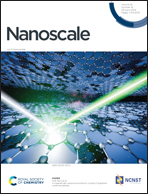Microscopy aided detection of the self-intercalation mechanism and in situ electronic properties in chromium selenide†
Abstract
Two-dimensional (2D) chromium-based self-intercalated materials Cr1+nX2 (0 ≤ n ≤ 1, X = S, Se, Te) have attracted much attention because of their tunable magnetism with good environmental stability. Intriguingly, the magnetic and electrical properties of the materials can be effectively tuned by altering the coverage and spatial arrangement of the intercalated Cr (ic-Cr) within the van der Waals gap, contributing to different stoichiometries. Several different Cr1+nX2 systems have been widely investigated recently; however, those with the same stoichiometric ratio (such as Cr1.25Te2) were reported to exhibit disparate magnetic properties, which still lacks explanation. Therefore, a systematic in situ study of the mechanisms with microscopy techniques is in high demand to look into the origin of these discrepancies. Herein, 2D self-intercalated Cr1+nSe2 nanoflakes were synthesized as a platform to conduct the characterization. Combining scanning transmission electron microscopy (STEM) and scanning tunneling microscopy (STM), we studied in depth the microscopic structure and local electronic properties of the Cr1+nSe2 nanoflakes. The self-intercalation mechanism of ic-Cr and local stoichiometric-ratio variation in a Cr1+nSe2 ultrathin nanoflake is clearly detected at the nanometer scale. Scanning tunneling spectroscopy (STS) measurements indicate that Cr1.5Se2/Cr2Se2 and Cr1.25Se2 exhibit conductive and semiconductive behaviors, respectively. The STM tip manipulation method is further applied to manipulate the microstructure of Cr1+nSe2, which successfully produces clean zigzag-type boundaries. Our systematic microscopy study paves the way for the in-depth study of the magnetic mechanism of 2D self-intercalated magnets at the nano/micro scale and the development of new magnetic and spintronic devices.



 Please wait while we load your content...
Please wait while we load your content...